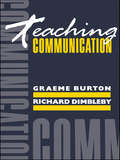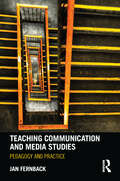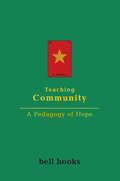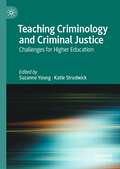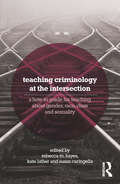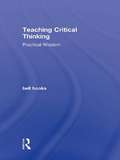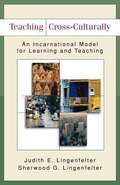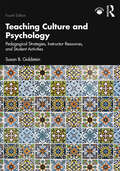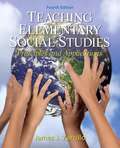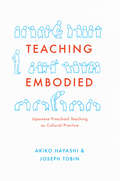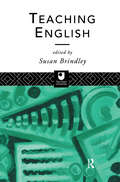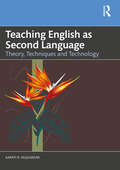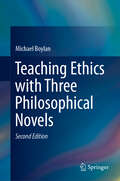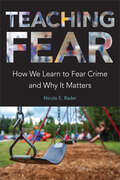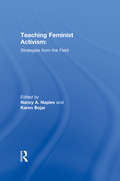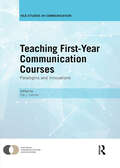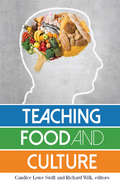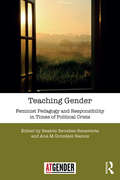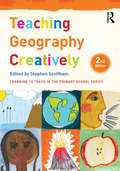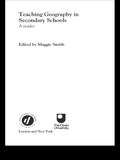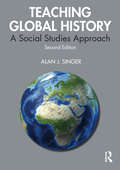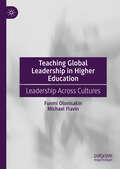- Table View
- List View
Teaching Communication
by Graeme Burton Richard DimblebyWe learn most of our communication skills without consciously working at them. Teaching Communication sets out what those skills are and how to develop them.
Teaching Communication and Media Studies: Pedagogy and Practice
by Jan FernbackDesigned for communication/media educators and graduate students, Teaching Communication and Media Studies is a practical and conceptual guide to teaching university courses in communication and media studies. Relying on her extensive experience instructing graduate students on the ins and outs of teaching, Jan Fernback discusses theoretical and applied topics central to contemporary mediated communication instruction, offering instructors at all levels strategies they can use to create a successful classroom experience. Fernback also considers the logic, design and delivery of courses in communication and media studies, while encouraging readers to reflect on their own strategic pedagogical decisions. Supplemented with interviews of successful communication instructors and sample exercises, this book is a must-have resource for all those teaching communication and media studies courses, regardless of level of experience.
Teaching Communication: Theory, Research, and Methods
by Gustav W. Friedrich Anita L. Vangelisti John A. DalyThe field of communication was founded, in part, because of a need to make people better communicators. That meant teaching them how to communicate more effectively, whether it be in public settings or in private. Most of that teaching has happened within the classroom and many professionals have spent their lives instructing others on various aspects of communication. Inside this second edition, the editors have assembled a fully comprehensive and contemporary discussion of topics and issues concerning the teaching of communication. The chapters contained herein--contributed by key voices throughout the communication discipline--address conceptual as well as practical issues related to communication instruction. The contents of this new edition reflect the dramatic changes that have occurred in communication education since the publication of the first edition in 1990. This book focuses initially on the goals of communication education, then delves into the preparation of specific communication courses. It includes assistance for instructors in organizing instructional content and discusses the use of instructional strategies and tools, as well as offering ideas on evaluating the processes and products of instruction. The volume also covers unique teaching assignments that may be encountered, from the basic course to continuing education, and addresses 2-year college teaching, directing forensic programs, distance education, and consulting. It concludes with important professional issues faced by both new and experienced communication instructors, including ethics and political issues within classrooms and departments. This volume is a necessity for anyone starting out a career as a communication instructor. Veteran educators--who know that learning to teach is a continual growth experience--will find useful and invaluable information within the book's pages. Whatever background and level of experience, all communication educators will find this new edition to be an essential resource for their work.
Teaching Community: A Pedagogy of Hope
by bell hooksTen years ago, bell hooks astonished readers with Teaching to Transgress: Education as the Practice of Freedom. Now comes Teaching Community: A Pedagogy of Hope - a powerful, visionary work that will enrich our teaching and our lives. Combining critical thinking about education with autobiographical narratives, hooks invites readers to extend the discourse of race, gender, class and nationality beyond the classroom into everyday situations of learning. bell hooks writes candidly about her own experiences. Teaching, she explains, can happen anywhere, any time - not just in college classrooms but in churches, in bookstores, in homes where people get together to share ideas that affect their daily lives. In Teaching Community bell hooks seeks to theorize from the place of the positive, looking at what works. Writing about struggles to end racism and white supremacy, she makes the useful point that "No one is born a racist. Everyone makes a choice." Teaching Community tells us how we can choose to end racism and create a beloved community. hooks looks at many issues-among them, spirituality in the classroom, white people looking to end racism, and erotic relationships between professors and students. Spirit, struggle, service, love, the ideals of shared knowledge and shared learning - these values motivate progressive social change. Teachers of vision know that democratic education can never be confined to a classroom. Teaching - so often undervalued in our society -- can be a joyous and inclusive activity. bell hooks shows the way. "When teachers teach with love, combining care, commitment, knowledge, responsibility, respect, and trust, we are often able to enter the classroom and go straight to the heart of the matter, which is knowing what to do on any given day to create the best climate for learning."
Teaching Contested Narratives
by Michalinos Zembylas Zvi BekermanIn troubled societies narratives about the past tend to be partial and explain a conflict from narrow perspectives that justify the national self and condemn, exclude and devalue the 'enemy' and their narrative. Through a detailed analysis, Teaching Contested Narratives reveals the works of identity, historical narratives and memory as these are enacted in classroom dialogues, canonical texts and school ceremonies. Presenting ethnographic data from local contexts in Cyprus and Israel, and demonstrating the relevance to educational settings in countries which suffer from conflicts all over the world, the authors explore the challenges of teaching narratives about the past in such societies, discuss how historical trauma and suffering are dealt with in the context of teaching, and highlight the potential of pedagogical interventions for reconciliation. The book shows how the notions of identity, memory and reconciliation can perpetuate or challenge attachments to essentialized ideas about peace and conflict.
Teaching Criminology and Criminal Justice: Challenges for Higher Education
by Suzanne Young Katie StrudwickThis book addresses the challenges within teaching Criminology and Criminal Justice, for students studying and academics involved in designing and delivering courses at an undergraduate and postgraduate level. The book highlights a number of contemporary issues through a wide context of themes and reflections of practice. The chapters are arranged in thematic parts: firstly ‘the challenges of diversity and inclusion’ secondly ‘challenges of creating authentic learning environments', and lastly ‘the challenge of creating transformative conversation’. These themes discuss different teaching approaches and present materials which address questions relevant for meeting the challenges. The book focuses on the role and impact of teaching Criminology and Criminal Justice in the real world and explores debates which have autonomy in their questioning and overlapping themes. The narratives reflect upon others’ experiences and explore transformative learning and innovation in Criminology and Criminal Justice.
Teaching Criminology at the Intersection: A how-to guide for teaching about gender, race, class and sexuality
by Susan Caringella Rebecca M. Hayes Kate LutherTeaching about gender, race, social class and sexuality in criminal justice and criminology classrooms can be challenging. Professors may face resistance when they ask students to examine how gender impacts victimization, how race affects interactions with the police, how socioeconomic status shapes experiences in court or how sexuality influences treatment in the criminal justice system. Teaching Criminology at the Intersection is an instructional guide to support faculty as they navigate teaching these topics. Bringing together the experience and knowledge of expert scholars, this book provides time-strapped academics with an accessible how-to guide for the classroom, where the dynamics and discrimination of gender, race, class and sexuality demographics intersect and permeate criminal justice concerns. In the book, the authors of each chapter discuss how they teach a particular contemporary criminal justice issue and provide their suggestions for best practice, while grounding their ideas in pedagogical theory. Chapters end with a toolkit of recommended activities, assignments, films, readings or websites. As a teaching handbook, Teaching Criminology at the Intersection is appropriate reading for graduate level criminology, criminal justice and women’s and gender studies teaching instruction courses and as background reading and reference for instructors in these disciplines.
Teaching Critical Thinking: Practical Wisdom
by Bell HooksIn Teaching Critical Thinking, renowned cultural critic and progressive educator bell hooks addresses some of the most compelling issues facing teachers in and out of the classroom today. In a series of short, accessible, and enlightening essays, hooks explores the confounding and sometimes controversial topics that teachers and students have urged her to address since the publication of the previous best-selling volumes in her Teaching series, Teaching to Transgress and Teaching Community. The issues are varied and broad, from whether meaningful teaching can take place in a large classroom setting to confronting issues of self-esteem. One professor, for example, asked how black female professors can maintain positive authority in a classroom without being seen through the lens of negative racist, sexist stereotypes. One teacher asked how to handle tears in the classroom, while another wanted to know how to use humor as a tool for learning. Addressing questions of race, gender, and class in this work, hooks discusses the complex balance that allows us to teach, value, and learn from works written by racist and sexist authors. Highlighting the importance of reading, she insists on the primacy of free speech, a democratic education of literacy. Throughout these essays, she celebrates the transformative power of critical thinking. This is provocative, powerful, and joyful intellectual work. It is a must read for anyone who is at all interested in education today.
Teaching Cross-Culturally: An Incarnational Model for Learning and Teaching
by Sherwood G. Lingenfelter Judith E. LingenfelterThe goal of this book is to help teachers understand their own culture of teaching and learning and also equip teachers to become effective learners in another cultural context, with specific focus on learning for teaching.
Teaching Culture and Psychology: Pedagogical Strategies, Instructor Resources, and Student Activities
by Susan B. GoldsteinThe fourth edition of Teaching Culture and Psychology (previously Cross-Cultural Explorations) provides an array of carefully designed instructor resources and student activities that support the construction and implementation of courses on culture and psychology.Revised and expanded from previous editions, the book enables instructors to use selected activities appropriate for their course structure. Part One explores a variety of pedagogical challenges involved in teaching about culture and psychology and details specific strategies for addressing these challenges. Part Two (instructor resources) and Part Three (student handouts) center around 90 activities designed to encourage students to think critically about the role of culture in a wide range of psychology content areas. These activities are based on current and classic cross-cultural research and take the form of case studies, self-administered scales, mini-experiments, database search assignments, and the collection of content-analytic, observational, and interview data. For each activity, instructors are provided with a lecture/discussion module as well as suggestions for variations and expanded writing assignments. Student handouts are available in this text as well as on the Routledge website as fillable forms.Contributing to the inclusion of cultural perspectives in the psychology curriculum, this wide-ranging book enables instructors to provide students with hands-on experiences that facilitate the understanding and application of major concepts and principles in the study of culture and psychology, making it ideal for cultural psychology, anthropology, sociology, and related courses.
Teaching Elementary Social Studies: Principles and Applications
by James J. ZarrilloLearn how to meet the needs of the diverse students in your first classroom through this unique elementary social studies methods textbook. With a unifying theme of diversity, it emphasizes differentiated instruction and meeting the needs of all students, including special attention to English learners, children with mild learning disabilities, and gifted students Chapters on differentiated instruction (Chapter 4) and culturally-responsive teaching (Chapter 5) provide a strong foundation and context for the strategies and teaching tips that follow in later chapters. Reflecting the national trends toward standards-based instruction and greater utilization of technology, this book is a great resource for your first classroom and beyond Read and reference this text for comprehensive coverage including new chapters on teaching geography and the literacy and social studies connection, as well as existing chapters on the history and current status of social studies; lesson and unit planning; cooperative learning; critical thinking; technology; assessment; integrating the language arts, the visual arts, and the performing arts; citizenship education; history and geography; and the other social sciences. Finally, instructors and students have praised earlier editions of this book because of its pragmatic and accessible style.
Teaching Embodied: Cultural Practice in Japanese Preschools
by Joseph Tobin Akiko HayashiWhen we look beyond lesson planning and curricula--those explicit facets that comprise so much of our discussion about education--we remember that teaching is an inherently social activity, shaped by a rich array of implicit habits, comportments, and ways of communicating. This is as true in the United States as it is in Japan, where Akiko Hayashi and Joseph Tobin have long studied early education from a cross-cultural perspective. Taking readers inside the classrooms of Japanese preschools, Teaching Embodied explores the everyday, implicit behaviors that form a crucially important--but grossly understudied--aspect of educational practice. Akiko Hayashi and Joseph Tobin embed themselves in the classrooms of three different teachers at three different schools to examine how teachers act, think, and talk. Drawing on extended interviews, their own real-time observations, and hours of video footage, they focus on how teachers embody their lessons: how they use their hands to gesture, comfort, or discipli≠ how they direct their posture, gaze, or physical location to indicate degrees of attention; and how they use the tone of their voice to communicate empathy, frustration, disapproval, or enthusiasm. Comparing teachers across schools and over time, they offer an illuminating analysis of the gestures that comprise a total body language, something that, while hardly ever explicitly discussed, the teachers all share to a remarkable degree. Showcasing the tremendous importance of--and dearth of attention to--this body language, they offer a powerful new inroad into educational study and practice, a deeper understanding of how teaching actually works, no matter what culture or country it is being practiced in.
Teaching English
by Susan BrindleyThis book offers an opportunity to engage with the debates in English teaching and to explore the viewpoints of writers who have contributed to those debates. It provides invaluable introduction to the complexities of English to Novice English teachers.
Teaching English Learners in Inclusive Classrooms
by Elda DuránTeachers and teacher trainers will find this clear, well-written text to be an invaluable resource in addressing the needs of myriad and unique students, especially those with disabilities.
Teaching English as Second Language: Theory, Techniques and Technology
by Aarati R MujumdarThis multidisciplinary volume is a systematic, well-researched resource to help understand the methods and techniques of teaching English as a second language. It integrates theory with praxis, drawing on the Cognitivist–Social interactionist theory and Constructivist approaches adopted in an English classroom. It provides insights into recent trends in teaching, given the changed teaching–learning scenario in education, while simultaneously aiding in the development of the 4IR skills much needed in the 21st century.Written in an easy-to-understand language, the book expounds on various language skills and their application in real-world classrooms. These classroom-tested techniques can be used by teachers by modifying the context in which they are used. The tasks help develop critical-thinking and problem-solving abilities in learners. The techniques and practices elucidated in the book are designed to be accessible to a global readership.This book will be useful to students, pre-service teachers, and researchers, who are new to the teaching of English Language. It will also be an essential companion to practicing in-service teachers and Teacher Trainers to further sharpen their concepts and skills.
Teaching Ethics with Three Philosophical Novels
by Michael BoylanThis book offers a unique method for teaching ethics and social/political philosophy by combining primary texts and resource material along with three philosophical novels so that students can apply the abstract principles to real-life situations. A sample syllabus and sample assignments are provided. This second edition contains an additional teacher's manual, guiding instructors in how to effectively put together a course in ethics using fiction. Students often turn-off when confronted with abstract ethical principles, alone. This book allows interaction with philosophical novels that provide real-life situations that mirrors applying normative principles to lived experience. Students will be drawn into this realism and their engagement with the material will be significantly enhanced. This is an innovative textbook for teachers and students of general philosophy, ethics, business ethics, social and political philosophy, as well as students of literature and philosophy.
Teaching Fear: How We Learn to Fear Crime and Why It Matters
by Nicole E. RaderWhere do lessons of “stranger danger” and safety come from—and do they apply differently for women? A gender-fear paradox shows that although women are less likely to be victims of most crimes (sexual assault aside), their fear of crime is greater. Moreover, girls and women—especially White women—are taught to fear the wrong things and given impossible tools to prevent victimization. In Teaching Fear, Nicole Rader zooms in on the social learning process, tracing the ways that families, schools, and the media have become obsessed with crime myths, especially regarding girls and women. Based on in-depth research and family studies, Rader reveals the dubious and dangerous origins of many of the most prominent safety guidelines that teach young girls to be more afraid of crime. These guidelines carry over to adulthood, influencing women’s behaviors and the way they order their worlds, with dangerous consequences. As women teach their learned behavior and conditioned fear to others, gendered crime myths are recirculated from generation to generation, making them a staple in our society. Teaching Fear includes suggestions for taking precautionary measures and crime prevention strategies. Rader also provides guidance for instilling safety values and demonstrating how we can “teach fear better” to break this cycle and truly create greater security.
Teaching Feminist Activism: Strategies from the Field
by Nancy A. Naples Karen BojarFrom theoretical analysis to practical teaching tools, an indispensable guide for educators seeking to link feminist theory and activism to their teaching. Included are web sites, videos, recommended texts, and additional course outlines.
Teaching First-Year Communication Courses: Paradigms and Innovations
by Pat J. GehrkeIn this book, eleven teacher-scholars of communication provide a robust study of the challenges and opportunities facing those who teach first-year communication courses. The first half of the volume offers paradigmatic analyses, including a survey of the ecology of the first-year course, a plea to integrate our first-year courses into our research agendas, a study of the gap between scholarship and pedagogy within rhetoric, a proposal for seven core competencies to unify the various first-year communication courses, and an argument for a critical communication paradigm. The second half details innovations in classroom practice, such as the teaching techniques of social justice pedagogues, team-based learning as a model for the public speaking course, response and feedback techniques in teaching public speaking at the University of Copenhagen, teaching online speech as a new course focused on the unique challenges of digital communication, and the role of oral interpretation and performance classes in the first-year curriculum. Finally, this volume concludes with the editor’s manifesto for teaching public speaking.
Teaching Food and Culture
by Richard R Wilk Candice Lowe SwiftWith the rapid growth and interest in food studies around the U.S. and globally, the original essays in this one-of-a-kind volume aid instructors in expanding their teaching to include both the latest scholarship and engage with public debate around issues related to food. The chapters represent the product of original efforts to develop ways to teach both with and about food in the classroom, written by innovative instructors who have successfully done so. It would appeal to community college and university instructors in anthropology and social science disciplines who currently teach or want to develop food-related courses. This book -illustrates the creative ways that college instructors have tackled teaching about food and used food as an instructional device;-aims to train the next generation of food scholars to deal with the complex problems of feeding an ever-increasing population -contains an interview with Sidney Mintz, the most influential anthropologist shaping the study of food
Teaching Gender: Feminist Pedagogy and Responsibility in Times of Political Crisis (Teaching with Gender)
by Beatriz Revelles-Benavente Ana M. González RamosTeaching Gender: Feminist Pedagogy and Responsibility in Times of Political Crisisaddresses the neoliberalization of the university, what this means in real terms, and strategic pedagogical responses to teaching within this context across disciplines and region. Inspired by bell hooks' "transgressive school" and Donna Haraway's "responsibility", this collection promotes a politics of care within the classroom through new forms of organizational practices. It engages with the challenges and possibilities of teaching students about women and gender by examining the multiple pedagogical, theoretical, and political dimensions of feminist learning. The book revisits how we can reconfigure a feminist politics of responsibility that is able to respond to or engage with contemporary crises. It also conceptualizes crisis and explains how it is transforming contemporary societies and affecting individual vulnerabilities and institutional structures. Finally, it offers practical cases from different European locations, in which crisis and responsibility have served to reformulate contemporary feminist pedagogies, altering curriculums, reframing institutions, and affecting the process of teaching and learning.
Teaching Geography Creatively (Learning to Teach in the Primary School Series)
by Stephen ScoffhamTeaching Geography Creatively was Winner of the Geographical Association Gold Award 2014 and Winner of the Geographical Association Silver Award 2017. This fully updated second edition of Teaching Geography Creatively is a stimulating source of guidance for busy trainee and experienced teachers. Packed full of practical approaches for bringing the teaching of geography to life, it offers a range of innovative ideas for exploring physical geography, human geography and environmental issues. Underpinned by the very latest research and theory, expert authors from schools and universities explore the inter-relationship between creativity and learning, and consider how creativity can enhance pupils’ motivation, self-image and well-being. Two brand new chapters focus on creative approaches to learning about the physical world, as well as the value of alternative learning settings. Further imaginative ideas include: games and starter activities as entry points for creative learning how to keep geography messy the outdoors and learning beyond the classroom how to teach geography using your local area the links between geography and other areas of the curriculum looking at geography, creativity and the future fun and games in geography engaging with the world through picture-books teaching about sustainability. With contemporary, cutting-edge practice at the forefront, Teaching Geography Creatively is an essential read for all trainee and practicing teachers, offering a variety of practical strategies to create a fun and stimulating learning environment. In the process it offers a pedagogy that respects the integrity of children as joyful and imaginative learners and which offers a vision of how geography can contribute to constructing a better and more equitable world.
Teaching Geography in Secondary Schools: A Reader
by Maggie SmithA companion to Aspects of Teaching Secondary Geography, Teaching Geography in the Secondary School: A Reader brings together a wide range of key writings that look at central issues, debates and ideas surrounding geography education today. It encourages students to reflect critically upon the issues in order to develop their understanding of these issues and to consider the implications for their classroom practice.
Teaching Global History: A Social Studies Approach
by Alan J. SingerThis updated edition of Teaching Global History challenges prospective and beginning social studies teachers to formulate their own views about what is important to know in global history and why. This essential text explains how to organize curriculum around broad social studies concepts and themes, as well as student questions about humanity, history, and the contemporary world. All chapters feature lesson ideas, a sample lesson plan with activity sheets, primary source documents, and helpful charts, graphs, photographs, and maps. This new edition includes connections to the C3 framework, updates throughout to account for the many shifts in global politics, and a new chapter connecting past to present through current events and historical studies in ways that engage students and propel civic activism. Offering an alternative to pre-packaged textbook outlines and materials, this text is a powerful resource for promoting thoughtful reflection and debate about what the global history curriculum should be and how to teach it.
Teaching Global Leadership in Higher Education: Leadership Across Cultures
by Michael Flavin Funmi OlonisakinThis book answers a need for pedagogic guidance and instruction in designing, implementing and evaluating global leadership as an academic subject. The book understands global leadership as a social practice and as a comparative subject, analysing how leadership is conceived of and practised in different countries and cultures. At the same time, the authors see global leadership from a ‘grand challenges’ perspective, engaging with the key issues of the age, some of which are identified through the United Nations’ Sustainable Development Goals. By these means, the book proposes a distinctive global leadership curriculum with potential to aggregate and unify different approaches to the subject. The book provides the conceptual underpinning, the multicultural perspective and the practical guidance to help universities worldwide in designing and developing curricula in global leadership, a subject of increasing interest in the twenty-first century as the geopolitical, even existential challenges of the age require both research and practice which transcends the boundaries of both nations and of academic disciplines. The book will also be of interest to researchers and practitioners in the fields of educational development and pedagogy.
